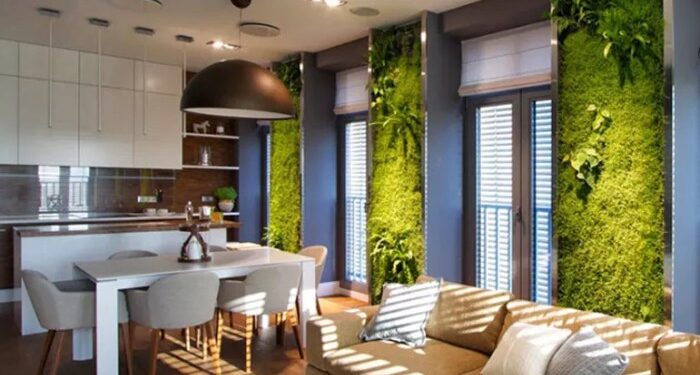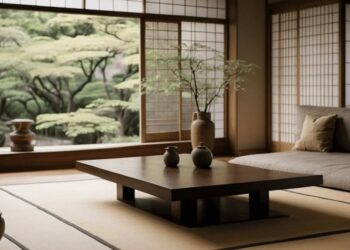Modern interior ideas for eco-conscious families sets the stage for this enthralling narrative, offering readers a glimpse into a story that is rich in detail and brimming with originality. From incorporating sustainable materials to energy-efficient solutions, this topic explores the perfect blend of modern aesthetics and eco-friendly principles.
As we delve deeper into the latest trends, sustainable furniture choices, energy-efficient lighting solutions, and the benefits of indoor plants, you'll discover how to create a harmonious and environmentally-friendly living space that resonates with your values.
Modern Interior Design Trends
In today's world, modern interior design trends are increasingly focusing on sustainability and eco-conscious practices. Families are looking for ways to create stylish and functional spaces while minimizing their environmental impact. Here are some of the latest trends in modern interior design that cater to eco-conscious families:
Sustainable Materials
Using sustainable materials is a key trend in modern interior design for eco-conscious families. Materials such as reclaimed wood, bamboo, cork, and recycled glass are popular choices for furniture, flooring, and decor. These materials not only reduce the carbon footprint but also add a unique and natural touch to the space.
Energy-Efficient Solutions
Incorporating energy-efficient solutions into modern interior design is another important trend for eco-conscious families. LED lighting, smart thermostats, low-flow plumbing fixtures, and energy-efficient appliances are just a few examples of how families can reduce their energy consumption and lower their utility bills while creating a modern and sustainable living environment.
Biophilic Design
Biophilic design, which focuses on connecting people with nature within the built environment, is a growing trend in modern interior design. Incorporating elements such as indoor plants, natural light, and nature-inspired patterns and textures can help improve air quality, reduce stress, and create a calming and rejuvenating atmosphere for eco-conscious families.
Minimalist Aesthetics
Minimalist aesthetics continue to be a popular trend in modern interior design, especially for eco-conscious families who value simplicity and decluttered spaces. Choosing quality over quantity, opting for multifunctional furniture, and embracing a neutral color palette are all key elements of minimalist design that promote a sustainable and mindful lifestyle.
Smart Home Technology
Integrating smart home technology into modern interior design is not only convenient but also beneficial for eco-conscious families. Smart devices such as thermostats, lighting systems, and security cameras can help monitor and reduce energy consumption, optimize comfort, and enhance the overall efficiency of the home while aligning with sustainable living practices.
Sustainable Furniture Choices
When it comes to creating a sustainable interior space for eco-conscious families, choosing the right furniture is crucial. Sustainable furniture options not only reduce environmental impact but also contribute to a healthier living environment.
Bamboo Furniture
Bamboo is a popular choice for sustainable furniture due to its rapid growth rate and renewability. It is a durable material that can withstand everyday use, making it ideal for eco-friendly households. Bamboo furniture is known for its strength and natural beauty, adding a touch of elegance to any room.
Reclaimed Wood Furniture
Reclaimed wood furniture is another sustainable option that is gaining popularity among environmentally conscious consumers. By using wood sourced from old buildings, barns, or other structures, this furniture helps reduce deforestation and waste. The unique character and history of reclaimed wood add a rustic charm to interior spaces.
Recycled Plastic Furniture
Recycled plastic furniture is an innovative choice for eco-conscious families looking to reduce plastic waste. By using recycled plastic materials, this type of furniture helps divert plastic from landfills and oceans. It is durable, weather-resistant, and easy to clean, making it suitable for outdoor and indoor use.
Energy-Efficient Lighting Solutions
Energy-efficient lighting plays a crucial role in modern interior design for eco-conscious families by reducing electricity consumption and minimizing environmental impact. By incorporating sustainable lighting solutions, families can create a more eco-friendly and cost-effective living space.
Types of Energy-Efficient Lighting
- LED Bulbs: LED bulbs are highly energy-efficient and have a longer lifespan compared to traditional incandescent bulbs. They consume less electricity, emit less heat, and come in a variety of color temperatures to suit different preferences.
- Solar-Powered Lights: Solar-powered lights harness sunlight to generate electricity, making them a sustainable and renewable lighting option for both indoor and outdoor spaces. They can be a great choice for eco-conscious families looking to reduce their carbon footprint.
- Smart Lighting Systems: Smart lighting systems allow users to control the brightness, color, and scheduling of lights through a smartphone or smart home device. These systems optimize energy usage by adjusting lighting levels based on occupancy and natural light availability, helping families save on energy costs.
Enhancing Home Sustainability through Proper Lighting Design
Proper lighting design not only improves the aesthetic appeal of a home but also contributes to its overall sustainability. By strategically placing energy-efficient light sources and utilizing natural light, families can reduce energy consumption, lower utility bills, and create a more environmentally friendly living environment.
Indoor Plants and Biophilic Design
Indoor plants and biophilic design elements play a crucial role in creating eco-conscious interiors that promote sustainability and well-being.
By incorporating indoor plants into your living spaces, you not only enhance the aesthetic appeal of your home but also improve air quality by naturally filtering out toxins. Biophilic design principles focus on bringing elements of nature indoors, fostering a connection to the outdoors and promoting a sense of calm and tranquility.
Selecting Low-Maintenance Houseplants
- Choose plants like pothos, spider plants, or snake plants that require minimal care and can thrive in indoor environments with low light.
- Consider succulents or cacti for spaces with plenty of natural light, as they are drought-resistant and easy to maintain.
- Opt for plants that are known for air-purifying qualities, such as peace lilies or rubber plants, to improve indoor air quality.
Creating a Connection to Nature
- Integrate natural elements like wood, stone, or water features into your interior design to mimic outdoor environments.
- Position indoor plants near windows or in areas where you spend the most time to benefit from their calming effects and improve overall well-being.
- Use biophilic design principles to incorporate elements like natural light, greenery, and views of nature to create a harmonious and sustainable living space.
Concluding Remarks
In conclusion, modern interior ideas for eco-conscious families pave the way for a more sustainable and mindful approach to design. By embracing eco-friendly practices and innovative solutions, you can transform your living space into a sanctuary that not only looks stylish but also supports a greener future.
Key Questions Answered
How can I incorporate sustainable materials into my modern interior design?
You can opt for materials like bamboo, reclaimed wood, and recycled plastic to reduce your environmental impact while adding a modern touch to your decor.
What are some energy-efficient lighting options suitable for eco-conscious families?
LED bulbs, solar-powered lights, and smart lighting systems are great choices to enhance energy efficiency in your home.
Why is biophilic design important for eco-conscious interiors?
Biophilic design principles create a connection to nature within your home, promoting well-being and a sense of harmony with the environment.






